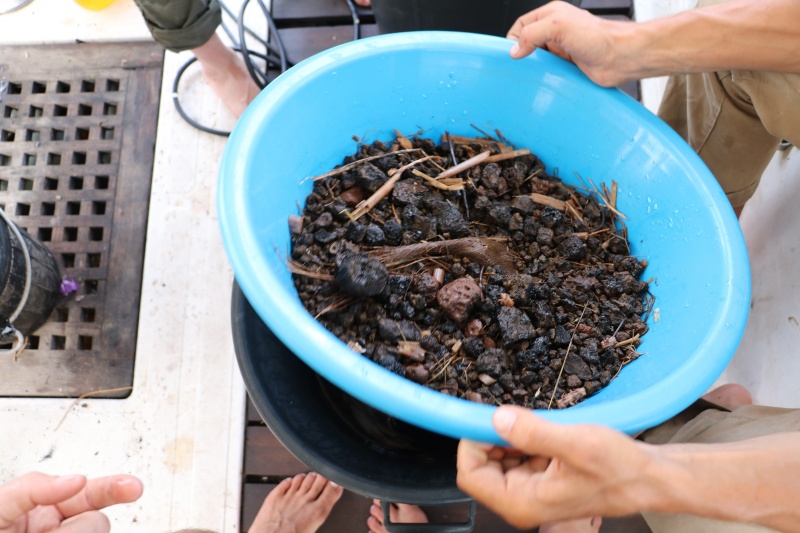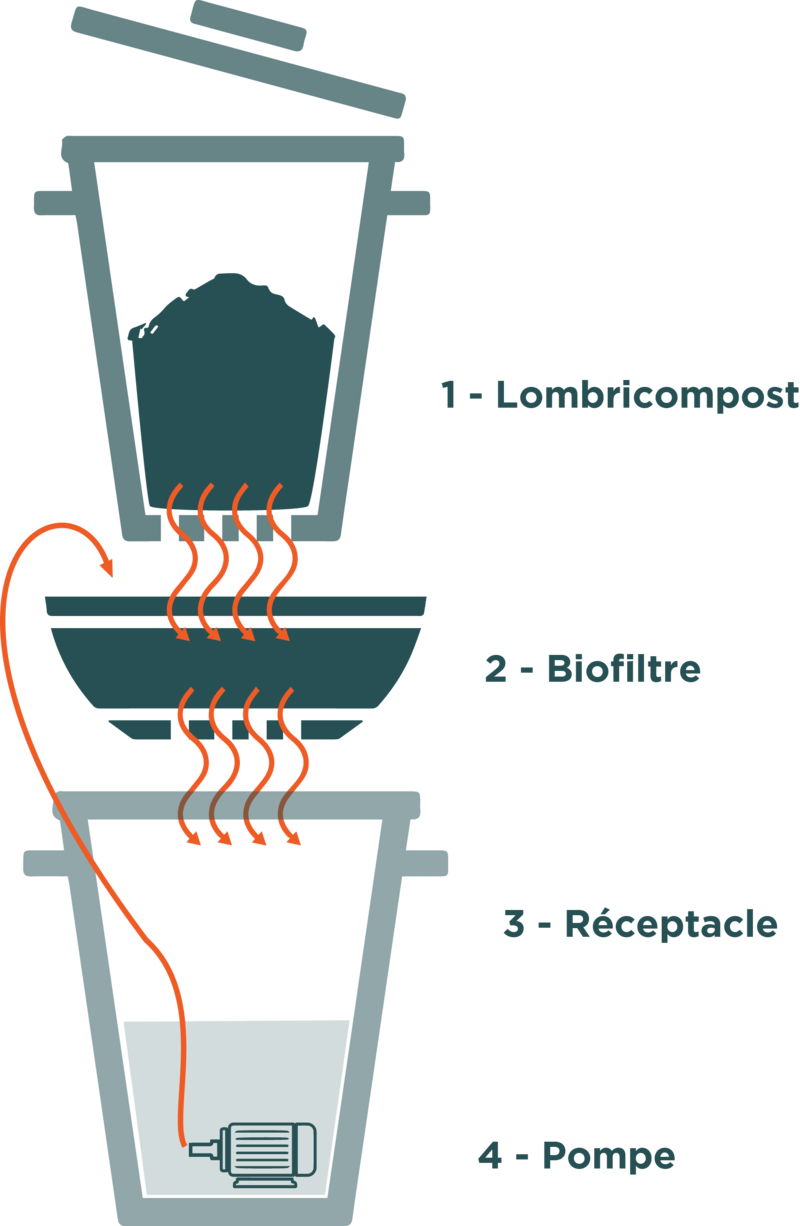Description
This filter creates the production of an organic fertilizer directly digestibale by plants by associating earthworm compost and organic filter.
Introduction
"The earthworm composting"
The earthworm compost is a system that enable the deterioration of our organic waste by worms (earthworm; precisely Eisenia Fetida), which is similar to the work of the living in the superficial layers of the soil. The waste (vegetable remains such as peeling or meal leftovers, but also animals carcass, excretions...) is used as food for microorganism (bacterium and mushrooms) and for worms present in the earthworm compost who eat and digest them. This digestion process enable to mineralize waste to transform it into simple elements digestible by plants (nitrogen, potassium, phosphorus, magnesium, calcium, iron, trace elements...) essentials for their growth and development.
Results of that digestion: percolate or compost juice and humus.
The "percolate" (liquid matter) is composed in nutrients, organics molecules yet non degraded, as well as beneficials microorganisms decomposers. It is composed of liquid excretions from earthworms, humidity from the compost and fresh matters that are going down due to gravity.
The "humus" (black matter, lumpy and humid at touch) contains minerals necessary for plants, humic acid (molecule which support roots ramification and their metabolism) and beneficials microorganisms decomposers. It serves as food safe by keeping nutrients to supply them for plants gradually and continuously.
"The Organic Filter"
It is a system in which decomposers microorganisms are going to finish the stage of "digestion" of chemicals compounds in order for them to be directly and easily available for plants. In a healthy soil, this method is happening continuously.
The liquid coming out of the filter is rich in elements easily digestible by plants and beneficials microorganisms. The interest of such a work of deconstruction in the organic filter avoids that the deconstruction take place in the roots of the plants and then creates rotten bits or deficiency. In this organic filter, this work is happening in aerobic, which means in oxygenated environment.
The organic filter consist in a energetic flow of the liquid (water and organics matters) with waterfall (oxygenating fountain) on microporous and aerated layers (volcanic rock, pumice stone, expanded clay beads) and aerated cellulosic layers favorable for fungal developments (straw, dry herbs, dry reeds...)
"Why combine earthworm compost and organic filter ?"
The percolate (or compost juice) collected after the composting isn't yet totally deteriorated. Adding an organic filter to the earthworm compost enable to finish preparing the different nutrients that the plants need in order to obtain an "fertilizer" usable even on an inert substrate (hydroponics) as well as bringing beneficials microorganisms to your system.
The humus can be gathered by sieving or after migration of the earthworm and can bu used to enrich a soil or a potted substrate. In this specific system, the earthworms establish their colony in the superior part (the first 15cm), the humus created stays in the inferior part and the percolate which is evacuated in the organic filter is enriching by going through the humus. This kind of earthworm composting is intended mostly for percolate gathering.
"Use context"
The earthworm composing can be perform to all size-cultures, from a community scale, to spread the large-scale cultures, or smaller one at home to produce for example, fertilizer for personal culture of the soil or hydroponics. This system is really interesting for isolated cultures with an agricultural activity, or even in urban areas in hydroponics (for example in roofing) because it enable to create a virtuous alimentation cycle by combining organic waste recycling and fertilizer production for plants.
This tutorial gives a way to create an homemade earthworm compost (around 50L per each of the organic filter system and earthworm composting). There are a lot of different ones in other sizes with different materials, but this one has been created to permit a reproduction by the greatest number and adaptable to each one local conditions.
Matériaux
- 2 vats of 60L each, such as black bins (strong inert plastic and preferably durable)
- 1 lid
- 1 basin of about 15L of the same diameter as the vats (strong inert plastic and preferably durable)
- water pump or lift pump basin or aquarium min 300L / h at H = 1m
- 50 cm garden hose (diameter adapted to the outlet of the pump)
* ball of expanded clay or porous volcanic rock (microporosity will be the solid habitat of microorganisms): about 5L for the organic filter and 5L for the earthworm composter (draining litter)
- straw / dry grass (degradable cellulosic habitat of microorganisms) about 5L for the organic filter and 5L for the earthworm composter
- water: about 40L
- fungi (Trichoderma or Streptomyces) (GHE - BM or Subculture) or decaying organic matter
- earthworms (at least 50 earthworms of the correct variety)
Outils
- Drill
Étape 1 - Manufacturing stages
1) The earthworm composter
2) The organic filter
3) The organic filter reservoir (Container and Pump)
Étape 2 - The earthworm composter
1) Drill 7 or 8 small holes in the bottom of one of the 60L vats using the drill.
2) Place the vat on top of the basin (organic filter).
3) Fill the earthworm compost with:
1st layer : porous rocks (bottom draining litter) and straw (first reproduction litter for the worms)
2nd layer : organic waste and 20 to 40 earthworms.
3rd layer : straw (second reproduction litter for the worms)
4) Recouvrir le lombricomposteur par un couvercle.
Étape 3 - Le biofiltre
1) Percez à l'aide d'une perceuse un trou au centre de votre bassine du diamètre de votre tuyau d'arrosage.
2) Percez de plus petits trous au fond de la bassine. Ils permettront au liquide de circuler de la bassine à la cuve.
3) Posez votre bassine par dessus votre cuve.
4) Faites passer le tuyau par le trou de la bassine en vérifiant que la pompe soit toujours plongée dans l'eau au fond de la cuve.
5) Remplissez la bassine avec la paille, les roches poreuses, les champignons. (à trouver chez GHE - General Hydroponics Europe, 10g/100L ou environ 2 cuillères à café).
Remarque : Il est également possible d'utiliser de la matière organique en décomposition. Les micro-organismes décomposeurs se trouvent par exemple sous une branche en décomposition et reconaissables par un film de moisissure blanchâtre.
6) Déposez éventuellement un bout de toile ajourée au dessus du tuyau permettant à l'eau de circuler sans laisser passer les roches ou la paille dans le tuyau.
Étape 4 - Le reservoir du biofiltre
1) Connectez votre pompe à votre tuyau d'arrosage.
2) Placez le tout au fond de la deuxième cuve de 60L.
3) Versez 15 à 20L d'eau dans la cuve.
Attention : Le niveau de liquide dans la cuve ne devra pas dépasser 40L afin de conserver un effet de cascade depuis le biofiltre. Le niveau ne devra pas être inférieur à 10L pour éviter de mettre la pompe à sec et risquer de la dégrader.
Étape 5 - Conseils d'utilisation
- Il est préférable d'alimenter le lombricompost par phase : un seau de 10L avec couvercle servira à regrouper les déchets (environ 1 semaine par exemple) avant de l'épandre dans le système. Recouvrez ensuite d'une couche d'environ 1cm de paille qui servira d'abris et de zone de reproduction aux lombrics en attendant le prochain épandage.
- Pour que la dégradation des déchets ait lieu correctement, certaines conditions doivent être réunies :
- une température et une humidité suffisantes : le lombricompost doit rester humide quitte à ajouter un peu d'eau par le dessus. N'hésitez pas à y verser vos fin de théière ou de cafetière (ils aiment beaucoup la caféine). L'eau (non salée!) du riz est aussi un régal pour les lombrics.
- un pH proche de la neutralité : le lombricompost doit être alimenté de manière équilibrée (pas que des pâtes par exemple)
- une bonne aération (une couche de paille d'environ 1cm après chaque ajout de déchet)
- Le percolat (jus du compost) se récupère facilement en vidant le contenu de votre réservoir. A l’aide d’un entonnoir, mettez le percolat en bouteille mais veillez à le laisser aéré car c'est un milieu vivant. Sans air la matière va fermenter et des odeurs nauséabondes risquent d'être très gênantes.
- Première récolte après 15 jours de fonctionnement du système. Application sur les plantes : 10ml pour 10 litres, augmentez suivant observation (si le milieu est vert pâle augmenter les doses).
Notes et références
Ce biofiltre a été réalisé avec l'aide deThomas Blanguille expert en hydroponie.
Visionner la vidéo Arte Future - Cap sur l'innovation en attendant le tutoriel.
N'hésitez pas à commenter, partager, et agrémenter le tutoriel d'informations utiles à son amélioration.
L’équipe du Low-Tech Lab vous invite également à consulter sa Biblilowtech.
Yes


 Français
Français English
English Deutsch
Deutsch Español
Español Italiano
Italiano Português
Português